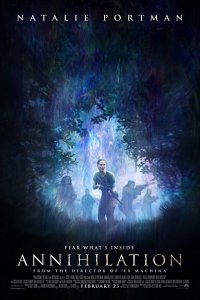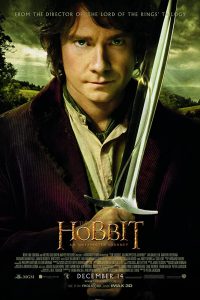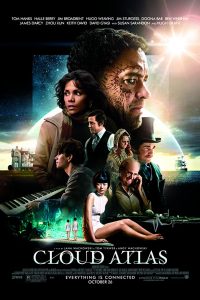Damaged Goods: Gary Westfahl reviews Annihilation
 Jeff VanderMeer’s 2014 novel Annihilation is a magical and mysterious book, and the simplest way to criticize Alex Garland’s film of the novel is to say that it is not a magical and mysterious film. To be sure, director and screenwriter Garland might protest that he did the best he could to convey the essence of VanderMeer’s novel while working within the confines of contemporary Hollywood filmmaking, but the bottom line, I reluctantly conclude, is that his film ultimately fails to recapture the spirit of the novel, although it might be satisfying to filmgoers who are unfamiliar with VanderMeer’s work.
Jeff VanderMeer’s 2014 novel Annihilation is a magical and mysterious book, and the simplest way to criticize Alex Garland’s film of the novel is to say that it is not a magical and mysterious film. To be sure, director and screenwriter Garland might protest that he did the best he could to convey the essence of VanderMeer’s novel while working within the confines of contemporary Hollywood filmmaking, but the bottom line, I reluctantly conclude, is that his film ultimately fails to recapture the spirit of the novel, although it might be satisfying to filmgoers who are unfamiliar with VanderMeer’s work.
For inveterate science fiction readers, the higher praise to offer VanderMeer’s Annihilation is that it invites comparison with Stanislaw Lem’s classic Solaris (1961) in depicting an encounter with an enigmatic alien presence, here not on a distant planet but in an isolated enclave on the American coast. Like Lem, VanderMeer offers only tentative theories, not definitive answers, to explain the strange events encountered by his twelfth, all-female expedition into “Area X,” and there is a sustained sense of quiet menace as the protagonist discovers strange writing consisting of organic material within a subterranean “tower.” Soon, all of the narrator’s colleagues either vanish or are killed; there is an eerily moaning animal lurking somewhere in the forest; it appears that, like Lem’s Solaris, an alien is endeavoring to communicate by replicating human forms; and ultimately, the narrator glimpses a being called the “Crawler” within the tower before resolving to remain within Area X indefinitely.
However, a Hollywood director cannot attract investors to provide $40,000,000 for his science fiction film by promising to provide an aura of “quiet menace”; so it is not surprising that Garland has, as it were, turned up the volume of VanderMeer’s story. While retaining the novel’s premise and its two major characters – the narrating “biologist” (now named Dr. Lena Kane) (Natalie Portman) and the untrustworthy “psychologist” (now named Dr. Ventress) (Jennifer Jason Leigh) – Garland has essentially abandoned VanderMeer’s story to provide a different series of more exciting adventures, also making the “anthropologist” (now named Cass Shepherd) (Tuva Novotny) more prominent and adding two new characters, Anya Thorensen (Gina Rodriguez) and Josie Radek (Tessa Thompson), to replace the “surveyor” and add some ethnic diversity. This more crowded cast of characters finds no unexpected tower but instead visits more familiar ruins while repeatedly battling against two enormous beasts resembling a crocodile and a bear. (Perhaps Garland pitched the film by exclaiming, “It’s Solaris meets Lake Placid!”) Later, to add some additional violence, they also start battling against each other, and one character is not allowed to die with dignity; rather, she suddenly starts breathing fire like Godzilla, looking rather silly, before being immolated in a sea of fire. Surgically removing one layer of uncertainty from VanderMeer’s plot, Garland eliminates the psychologist’s secret efforts to maintain hypnotic control over her cohorts – perhaps not wishing to offend the American Psychological Association – and Portman’s biologist always looks exactly the same, never developing a weird glow as in the novel. And in contrast to VanderMeer’s mildly aberrant environment, Garland increasingly sprinkles his world with all sorts of colorfully bizarre plants and animals, as Lena even announces: “The mutations were subtle at first, more extreme as we approached the lighthouse.” At some points, rather undermining the film’s unsettling atmosphere, they seem to be walking through Disneyland, not a dangerous terrain.
The most significant difference between the novel and the film, however, is that unlike VanderMeer, who offers only vague hints of an alien presence that is somehow absorbing and replicating the humans who enter Area X, Garland has physicist Radek explain exactly what is happening, in words of one syllable, which in my view weakens the story’s impact. For once the characters fully understand everything that is going on in Area X, the only remaining challenge is to locate and confront the entity who is causing all the changes. And while Garland’s conclusion is arguably congruent with the climax of the novel, the entire sequence struck me as too literal, too overt, too explicable – again subverting the key message in the novel, one found regularly in science fiction literature but rarely in science fiction films – that actual aliens are likely to be utterly inexplicable. It is ironic, then, that one of Lena’s recurring responses to questions is “I don’t know,” because by the end of the film audiences actually know too much about the story.
Cognizant of the need to avoid “spoilers,” I’ll say nothing else about the film’s final moments, but I can safely note a minor detail: at one moment, the entity I was looking at resembled an anthropomorphized monolith. It suddenly seemed clear that Annihilation, while lacking any other overt references to the film, represented Garland’s attempt to make his own version of Stanley Kubrick’s 2001: A Space Odyssey (1968). And like Christopher Nolan’s more obvious homage to Kubrick, Interstellar (2014 – review here), Garland’s film gets it all wrong. One problem has just been alluded to: Nolan and Garland feel compelled to keep explaining more and more, whereas Kubrick kept tinkering with the screenplay to explain less and less – making 2001 one of the rare science fiction films that recalls science fiction literature.
Second, science fiction filmmakers habitually conclude their fantastic stories by restoring the status quo, while science fiction writers – and Kubrick and Arthur C. Clarke’s screenplay – accept that the future may be irreversibly different from the present. At the end of 2001, humanity is poised to evolve into an entirely new species, with new powers and priorities; but Nolan concludes Interstellar by reinvigorating the good old human race in a cozy, idyllic space habitat. In the case of Annihilation, VanderMeer’s Area X continues to expand throughout the trilogy and seems destined to become a permanent fixture; Garland vaguely intimates that, somehow due to Lena’s actions, Area X is going to fade away, replacing VanderMeer’s unresolved dénouement with an envisioned return to a comfortable normalcy.
The third problem is that, rejecting the doggedly bland Heywood R. Floyd, David Bowman, and Frank Poole, Nolan and Garland burden all their characters with elaborate back stories and various traumas, allowing them to blatantly display their naked emotions. But Kubrick understood the point made long ago by C. S. Lewis in his essay “On Science Fiction”: “Every good writer knows that the more unusual the scenes and events of his story are, the more ordinary, the more typical his persons should be. Hence Gulliver is a commonplace little man and Alice a commonplace little girl. If they had been more remarkable they would have wrecked their books.” Illustrating the same principle, VanderMeer brilliantly makes his biologist narrator an introverted, reticent person, reluctant to reveal anything about her own life. While she eventually admits that she joined the expedition because her husband was part of a previous expedition, and comments on her unhappy childhood and complex relationship with her husband, she still provides only a selective portrait of her life and personality, and this enhances the novel by amplifying its aura of ambiguity – readers aren’t always sure exactly what she is feeling, or what she will do next. As for the other characters, all we learn comes from the biologist’s speculative impressions of their character and motives, and VanderMeer’s refusal to name the characters makes them seem even more elusive; before leaving, members of the expedition were instructed that “anything personal should be left behind,” reasonable advice for somebody telling a story with intriguing ideas.
In the film, though, everything is crystal clear about the characters, including their names. Lena Kane is a former soldier turned biology professor (a seemingly implausible career path, although a female veteran, Dr. Anne B. Alerding, is in fact currently a biology professor at the Virginia Military Institute), and she has one simple problem: she feels guilty about having an affair during one of her husband’s frequent absences. Dr. Ventress is dour and inclined to take risks because she is dying of cancer – a fact that VanderMeer only reveals in one of the sequels to Annihilation. Shepherd is mourning the death of her young daughter, a detail perhaps borrowed from the film Gravity (2013 – review here), and another character is a recovering drug addict. In one scene, Shepherd briskly summarizes her and the other characters’ issues and concludes, “We’re all damaged goods.” But the actual damaged good is VanderMeer’s haunting story, now cluttered with trite irrelevancies.
The film departs from the novel in other predictable ways. Instead of leaving behind boring journals to read, as in the novel, the film’s members of previous expeditions conveniently provide illuminating videos to watch. Although there is nothing particularly sinister about the secrecy surrounding the novel’s Area X, the film’s opening scenes depict Lena as the victim of a massive, malevolent government cover-up, adding some contrived drama to the expository scenes. And while accepting VanderMeer’s all-female expedition, Garland also wanted to work some men into the story, perhaps afraid of alienating some of his male viewers. Thus, Lena’s husband (Oscar Isaac) is repeatedly observed in flashbacks and clings to life throughout the events of the film, although he quickly died in the novel. We also see a lot of Lena’s male colleague Daniel (David Gyasi); the film’s added frame involves Lena being interrogated after she returns from Area X by a man (Benedict Wong) who alternately seems cold and sympathetic; and several men have minor roles in the scenes before and after the expedition. That these embellishments do little if anything to improve the story, I suppose, goes without saying.
Although I have so far dwelt on the flaws and weaknesses in Annihilation, I wouldn’t say that it’s an awful film; in fact, it’s a pretty good film, and as indicated, viewers who bring no expectations to the theatre may find it involving and enjoyable. The film also differs from other recent science fiction films in some admirable ways that merit some discussion.
First, unlike other filmmakers who are content to rely heavily on computer-generated animation, Garland manifestly wanted to engage in some real filmmaking. To be sure, the film’s credits include the usual interminable list of computer animators, indicating that he did make use of such effects, but the credits also list numerous carpenters, painters, plasterers, costumers, prop builders, and prosthetics experts, and the film’s most outré characters – the alligator, bear, and alien “humanoid” – are all portrayed by credited actors. The film, then, both is and appears to be documenting actual experiences, not artful illusions. In one scene, for example, a character quivers in fear as an enormous creature comes very close to her face, and it seems likely that the actor is responding to a physical object, instead of following instructions to imagine that the empty space next to her is a monster. No matter how much computer animation continues to improve, science fiction filmmakers, to make their fantastic projections seem genuine and plausible, may always need to sometimes construct actual sets and props and employ actors with prosthetics to portray their aliens.
Garland was also determined to provide his film with a solid scientific background; the credits list a “Scientific Advisor,” and he was an excellent one – Adam Rutherford, a prominent British geneticist. In part, I suspect, Rutherford’s contribution to the film was to point to pages in the script and tell Garland, “But that’s impossible”; and, unwilling to entirely abandon his story, Garland responded minimally by adding a line: Lena telling her colleagues, “But that’s impossible.” Still, the film does begin with Lena lecturing her students about how life began from a single cell that kept dividing to form two cells, four cells, eight cells, and so on to eventually create all life on Earth, and images of dividing cells recur throughout the film. In a flashback, Lena is observed reading Rebecca Skloot’s The Immortal Life of Henrietta Lacks (2010), about a long-dead woman whose cancer cells have continued replicating to this day, and this emphasis on dividing cells perhaps explains the film’s two excerpts from the Crosby, Stills and Nash song “Helplessly Hoping” (1969), with its chorus of increasing numbers: “They are one person, They are two alone, They are three together, They are for each other.” Cell division, also a process of cell death, is related to the film’s larger themes in one interesting exchange. Lena asks Ventress, “Why did my husband volunteer for a suicide mission?” She answers, “You’re confusing suicide with self-destruction,” going on to observe that “We all self-destruct,” not as a result of “decisions” but of an “impulse” that is “programmed into every cell” – and, presumably, into the complex organisms made up of cells. Yet some people are able to resist this “impulse,” as demonstrated when her interrogator says to Lena, “One by one – all gone – except you. How do you explain that?” Initially disinclined to answer, Lena finally says, “I had to come back – I’m not sure they did.”
Finally, Annihilation should be celebrated as another example of a heartening recent trend – major films based on excellent science fiction novels, welcome respites in a media landscape otherwise dominated by exhausted franchises limping toward their inevitable demise – like the Transformers films, the Pirates of the Caribbean films, and the Mission: Impossible films. After all, Lena defends the motives of the being within Area X by arguing that it wasn’t “destroying” but rather “changing – making something new”; and instead of pondering which past successes to reboot or sequelize, film producers would be well advised to look for something new, whether it is a worthwhile science fiction novel to adapt or a striking original screenplay (like Garland’s own Ex Machina [2015]). It is true that, as in this case, films based on novels may not live up to their distinguished source material, but at least some of their virtues survive the transition, and these films help draw attention to writers like Ted Chiang, Andy Weir, and VanderMeer who deserve to have more readers. Unfortunately, it will clearly take some time for Hollywood to change its habits, since Garland’s current project is a screenplay based on the Halo video game – a film that I will definitely not be reviewing.
Directed by Alex Garland
Written by Alex Garland, based on the novel by Jeff VanderMeer
Starring Natalie Portman, Jennifer Jason Leigh, Gina Rodriguez, Tessa Thompson, Tuva Novotny, Oscar Isaac, Benedict Wong, David Gyasi, Sammy Hayman, Josh Danford, John Schwab, and Sonoya Mizuno
Gary Westfahl has published 25 books about science fiction and fantasy, including Science Fiction Quotations: From the Inner Mind to the Outer Limits (2005), The Spacesuit Film: A History, 1918-1969 (2012), A Sense-of-Wonderful Century: Explorations of Science Fiction and Fantasy Films (2012); excerpts from these and his other books are available at his World of Westfahl website. He has also published hundreds of articles, reviews, and contributions to reference books. His most recent books are the three-volume A Day in a Working Life: 300 Trades and Professions through History (2015), An Alien Abroad: Science Fiction Columns from Interzone (2016), now available from Wildside Press, and the co-edited Bridges to Science Fiction and Fantasy: Outstanding Essays from the J. Lloyd Eaton Conferences (2018). His forthcoming books include Arthur C. Clarke, part of the University of Illinois Press’s Modern Masters of Science Fiction series.








Interesting review. I hadn’t even considered watching the film before I read this. Now, I definitely will.
Personally I think people who never bothered to learn other people’s names, much less never spoke them, are off somehow, unless they are criminals engaged in a criminal enterprise. In a book I suppose you can let the reader’s imagination seem to conjure up such mannikins, but in a movie, where the camera is simply photographing a real person, such self-deception is impossible.
I plan to see the movie as a fancy horror movie, and don’t anticipate anything but brain dead science, Adam Rutherford notwithstanding.
Ms Portman expressionless face is only one of the many factors making this movie a very long introduction to an end that dramatically lacks “sense of wonder”, once a criterion to decide whether it was science fiction or not.
Resembles “Arrival”, for those who have seen it, by leaving you nearly convinced of having learnt absolutely nothing. The reviewer underlines secundary flaws in the movie architecture, probably not to include spoilers.
Here is my uber-spoiler (should it resist the publisher…): this story cannot have spoilers…